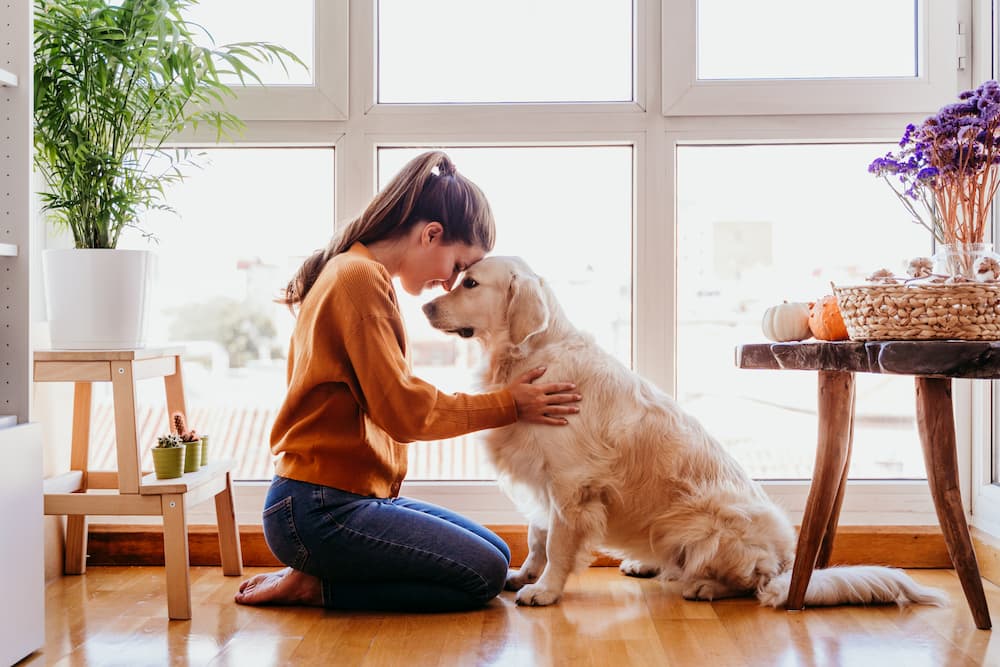When we talk about psychology, there’s not often a mention of our dog’s mental health. Much of the discussion about things like depression and stress refer to humans, not our canine counterparts. In fact, when you search dog’s mental health online, what you get is a long list of articles about how our dogs can help us with our own mental health issues.
But if we really want to be responsible Pet Owners, we should know how to read the signs of mental health issues in our dogs. Being able to treat any signs of emotional distress should be as normalised as taking our pups to the groomers or hiring an on-demand Dog Walker.
In this article, we’re going to discuss some issues and treatments to make sure we’re taking care of our dog’s mental health.
 What does your dog’s mental health look like?
What does your dog’s mental health look like?
Before diving right into trying to diagnose our dog’s mental health, it can be helpful to understand what a happy and content doggo looks like. Here are some telltale signs of a healthy pup:
- At mealtimes, your dog eats normally and isn’t possessive over their food bowl.
- Your dog is comfortable in their space, without hiding or lashing out at new people in their territory
- You don’t come home to destroyed furniture, a door or window that’s been scratched or chewed as your dog tried to escape
- You can’t see your dogs hip bones protruding
- Your dog isn’t overweight
- When you try to play with your dog, they are excited and engaged
- Poop is normal and consistent, and there are no other digestive issues like vomiting
If your dog shows all of these signs of a happy pup, congratulations! You’ve likely creative an environment that is perfect for your dog’s mental health.
Now, what about when your dog’s mental health isn’t all tail wags and puppy cuddles?
Common problems for a dog’s mental health
Our dogs can’t tell us what they’re thinking, but they can show us when something is bothering them. Here are a few ways that mental health issues can manifest in doggie behaviour:
- Aggression and possessiveness – many Dog Owners assume that aggression and possessiveness is a lack of training or an unfortunate breed quality. While that can be true in some cases, it’s important to remember that aggression stems from anxiety and fear. Dogs who are uncomfortable in their territory or feel that they have to fight for their resources will resort to aggression and possessiveness.
- Destruction of furniture – this can be a sign of a dog that is bored and lonely. This behaviour is often linked with separation anxiety.
- Lack of interest in toys, exercise, and food – If your doggo isn’t their normal bouncy, energetic self, take it as a huge red flag. Your dog might be experiencing canine stress or depression, or there may be something physical going on.
- Anti-social behaviour – Dogs are social by nature. And even if you have a dog breed that is known for independence, your pup should still seek out interaction.
- Vomiting – This may also be a sign of stress or physical condition.
- Excessive barking or howling – This is a common sign of loneliness or distress.
Alright, let’s take a pause. That’s a lot to keep in mind when it comes to your dog’s mental health. But, the more time you spend with your pup and get to know their personality, noticing changes in their behaviour will become second nature. If something is off, you’ll know. And there are plenty of things that you can do to improve the situation.

“Look, it’s not one big thing. It’s just a million LITTLE things…”
6 ways to improve your dog’s mental health
If you can commit to these doggie-focused steps, you’ll have a happy and healthy pup in your home.
#1: Take your dog to the vet regularly
In animals like dogs, physical issues and mental health issues are intimately linked. So, if you want to make sure that your dog is happy, make sure their body is in tip-top shape.
#2: Provide daily exercise and mental stimulation
You would be amazed at how many issues can be resolved with a little more time spent playing and exercising with your dog. Don’t forget that dogs need daily exercise, and they can benefit even more if you add a layer of mental stimulation in the form of training sessions or mental games.
If you don’t have the time to take your dog out every day, consider hiring a trusted Dog Walker near you.
#3: Make sure their living space is safe and peaceful
If your dog has territorial aggression but they spend all day in the yard watching other dogs walk right next to their territory, they’re going to feel stressed. Similarly, older dogs who just want peace and quiet may not be happy around young children.
One solution could be to introduce crate training to your dog to give them a place to feel safe. Or invest in a high-quality Calming bed that they can retreat to, to help them relax and reduce any anxiety.
#4: Feed them healthy foods
Diet can have a big impact on your dog’s mental health. So, always give them highly nutritious dog food. And, limit their access to human food which can be difficult for them to digest.
#5: Give your dog some TLC
What do most doggos want more than anything? Quality time with their beloved Owners. Make sure that your dog is getting plenty of attention and love from the humans around them.
#6: Help them cope with life changes
Like humans, dogs can feel loss and grief. Life changes like the loss of a doggie friend or a move to a new home can trigger sadness in dogs. Experts suggest that Dog Owners can help their doggies deal with depression by maintaining a sense of normalcy and giving them more time for exercise.
If you don’t see any changes in your dog, you can also talk to your vet for recommendations.
We hope this article has helped you to better understand your dog’s mental health. What do you do to make sure your pup is living their best life?


1 comment
Thanks for sharing the comprehensive post, your post having informative&valuable content,it will be helpfull.